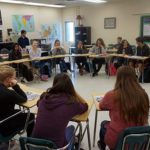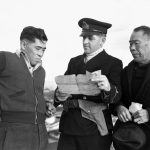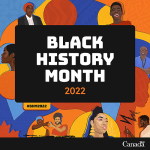
Risa Gluskin’s Interview with Hafiz Printer from the Archives of Ontario
Hafiz is the Senior Coordinator, Educational Programming and Exhibitions at the Archives of Ontario where he is developing workshops for teachers and students, including ones with a focus on gamification, use of film in the classroom, and use of primary sources, of course. Previously, he was Education Specialist at the Aga Khan Museum in Toronto. He is an award-winning teacher, having received the Prime Minister’s Award for Teaching Excellent Certificate in 2018.
Where/how did you develop your interest in games/ gamification?
Growing up our parents were pretty strict with how much tv we could watch or video games we could play. The exception was if it was educational, and being kids we thought we found a loophole so we would spend hours watching documentaries and playing history or language games. I didn’t realize it at the time, but it implanted the idea in my mind that learning should be engaging. When I was in school, I really enjoyed the classes and lessons where we took part in simulations, took on roles or had our learning acknowledged with stickers or the occasional personal pan pizza voucher.
The ball really started rolling in my first-year teaching. I was getting into board games as a hobby and like many teachers I started to think about how to bring my interest into the classroom. I ended up assigning students the task of creating a board game as an end of unit summative. It did not go well. So I started to dive into what goes into game design so I could model it for my students. And down the rabbit hole I went.
It has become a core part of my teaching since then. Sometimes it was actually creating a board game, simulation, or classroom escape room for students, but more often than not it was thinking about how games engage (e.g. by providing meaningful choices and social learning opportunities) and how to view my pedagogical approach overall through this lens.
How did you decide to move from the classroom to a museum setting (Aga Khan Museum, originally)?
My teaching journey has been a bit of a winding road. When I graduated teachers college there weren’t many openings available in Toronto so I went to teach overseas in India, Essen Germany, and London, UK while doing my Masters, before coming back to Canada to teach in Vancouver and Toronto. These experiences broadened my exposure to teaching and learning approaches.
By year 10 I felt I was ready for a change and took on a training and development role with an NGO to support teacher training in East Africa. It provided me the opportunity to continue doing international work while sharing my learnings in supporting teachers. This was in late 2019. During the pandemic I was fortunate enough to be home in Toronto but continued to support teacher training and development virtually. And then I burnt out.
Looking for a new opportunity that still allowed me to do something around education, a friend encouraged me to apply for the Education Specialist role at the Aga Khan Museum. I had never thought of working at a museum as an option before but was excited at the idea. They were looking for someone with a background in education and preferably Islamic studies as well and I had both.
Working at the Museum was a breath of fresh air and completely invigorated my teacher spirit. It allowed me to approach education in different ways from community outreach to program development, student field trips to teacher PDs. Being a non-traditional learning environment meant I had the creative freedom to try things that wouldn’t have been possible in a traditional classroom space.
What are some exciting aspects of working at the Archives of Ontario? (I would imagine it’s somewhat of a playground for interesting, maybe quirky, primary sources???)
You are literally surrounded by history! The other day I was looking through some World War 1 material while working on a school program and I was able to handle items from over 100 years ago. There is a sense of discovery as you do the research about what you are going to find. Sometimes what you find is a surprise as well. We run a Summer Teacher Institute and I was putting together a historical walking tour of downtown to model the process for educators and highlight the lived layers of history that a place can have. While looking through newspaper articles from the mid-1800s I came across a couple which spoke about a clown riot that took place in downtown Toronto which also involved firemen and ladies of the night. Definitely, not something I was looking for, let alone aware of, but it made it into the tour.
Aside from the amazing collection, we also get to interact a great deal with university students and professors, being located on the campus of York University. Professors will come in with particular classes and ask us to put something together for them. This past week for a 3rd year history course on childhood, we did a session on children’s toys from the 1800s to the present.
I also really love taking groups on tours through the space. Especially when we go into the vaults or the conservation area, the reactions from people who get to be in spaces they normally wouldn’t and also having that opportunity to be so close to these historical documents.
How can teachers make creative use of primary sources from the Archives or in general?
There are many different ways that teachers can get students to engage with primary sources in an interesting and engaging way. Oftentimes we present primary sources to students either to analyze what a primary source is or for them to look at the topic being covered in class rather than using the source as a jumping off point to have students engage with it in a meaningful way for them. Presenting it within a context or a theme can help build curiosity and interest. A map of a city presented as just that is very different from the same map presented to them when they are asked to use it to solve the mystery of a plague outbreak.
Here are a few examples of things that I’ve done with students that have worked well:
Historical Walking Tours: Have students look into the history of their community, school, or city and then put together a hunt. They can develop a theme, e.g. an architectural or immigrant history walking tour, and then research and use sources to find out more.
Models & Creating: Having students create is a great way to get them to engage. Model making of a historical building, tomb, a piece of technology. By creating they will get a deeper appreciation of the subject they are exploring, and sources can be used to ground what and how they create.
Historical Game: You can create a game for the classroom based on a particular period or event. In one of the educational games I made for a class, students took on the roles of different empires vying for power and influence in the region. I incorporated primary sources into the various cards and actions. Some acted as benefits, others as set backs. This helped to introduce students to concepts and ideas that I wouldn’t have been able to get across just by looking at those sources on their own.
Classroom Escape Room: These are great because students are applying their historical thinking skills in trying to solve the mystery. Students work together to uncover, analyze and synthesize the story you set up and need to refer to sources in order to do so.
There are many other things that you can do with primary sources, beyond the few listed above. The important thing is to look at them for a purpose beyond understanding what a primary source is. These are remnants of the past. What can they tell us about that time, the people, society.
And if you are interested in learning more about these approaches we do offer Teacher PD at the Archives!
In your opinion and experience, what does learning outside of the classroom bring to the classroom?
I used to love to take my students on field trips or have experiences outside of the classroom, even if it was taking them to the school field to do an experiment. There is a novelty to being in a different space, a sense of excitement and sometimes adventure. Depending on where you go students are exposed to expertise, items, history or experiences that you may not be able to create for them in the classroom. How many of us have ancient Egyptian mummies we can wheel out for students to explore? Students get to do things that they wouldn’t normally get the chance to do in the classroom. These spaces remove a lot of the constraints from the classroom.
Non-traditional learning environments help to create experiences; they offer a different kind of engagement. Most of us, when thinking back to our own school days, probably remember the field trips most vividly, whether it was visiting the ROM or going to a maple farm. Why is that? We got to move, we got to experiment, we got to be in places where history took place, we got to create. We also got to put ourselves into the shoes of people of the past. At the Aga Khan Museum we have a program where students create their own paints from natural materials, and then use them to paint traditional geometric patterns they created by hand, followed by a tour of the gallery to see the artefacts. The entire program is geared towards having students gain a deeper appreciation for the art and artists.
What else (beyond programs for teachers and students) are you responsible for at the Archives of Ontario?
On the education side of things, beyond teacher PDs and school group programs, I also support professors who want to bring their students to the archives. These include the teachers programs at York and OISE.
Outreach is another area that’s important. Working with our outreach team to give tours of the Archives, do outreach, and work with other cultural organizations like Defining Moments Canada, Myseum, and the Ontario Heritage Fair.
On the exhibitions side of my role I focus on both online and onsite exhibitions. I mainly facilitate the process in a project management role. This involves working with experts who have done the research, putting together an interpretation of this to make it more concise and accessible in order to get it ready for use, and working with our team to have the exhibitions realized.
What are some of the best reactions you’ve had from students and teachers to your creative and fun methods of engagement?
I’ve had some great reactions over the years. There is usually some confusion or incredulity from students at first but they are quick to jump right in. There is usually a buzz in the class, like “We get to play a game? FOR CLASS?!” It is always interesting to then see how they approach things when they are put in positions to make decisions in the game. The debriefs on these are always great.
It can get a bit rowdy sometimes. The one time I did a battle re-enactment with balloon swords and horses (really balloon dogs but the kids didn’t need to know that), a few popped and startled students. After class the teachers had the chance to play with them as well – students shouldn’t be the only ones to have some fun.
I really enjoy escape rooms because it flips the tables, where I get to stress out the students instead of the other way around. Because this one is so self directed, I get the chance to really watch and observe how students work together which always gives me new insights into them.
My favourite, however, was the reaction from the one curmudgeon teacher that every school seems to have (the one who makes life difficult for all teachers, and new teachers in particular) who was discouraging of any new approach I tried to use. They were very vocal about how I was wasting time in class, how this was not the right way to teach. As the term went on and test results came back, they became oddly silent, however. Who would have thought making learning enjoyable would actually engage students?


